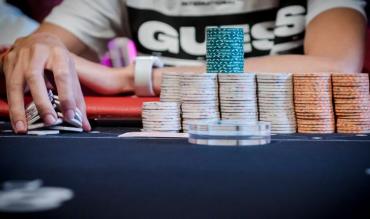So, you want to learn poker. You’ve got big dreams of pulling insane bluffs and scooping massive pots. Whenever someone starts talking poker, your eyes glaze over into dollar signs. Not to mention all the fun you’ll have – Hold‘em kicks in your adrenaline.
As you’ve probably already discovered, the only problem is that learning poker is -
- Challenging
- Technical
- Boring
While your hopes are high, so is the barrier to entry. Isn’t there an easier way?
How does one go from zero to hero… without going broke?
Not everyone wants to learn the hard way.
And while a few ups and downs are inevitable – hey, you can’t win every hand – it’s time to place you on solid footing. As the author of the beginners to intermediates book A Girl’s Guide to Poker, I know a thing or two about getting people up to speed. Especially newbies.
So don’t fret if you’re feeling totally green.
Here’s a simple version of poker for dummies.
In a Nutshell
Texas Hold‘em at its base is very simple. It’s a matching game. You receive two private hidden cards face down. The dealer will deal up to five public cards face up.
So, if you’re dealt an ace, and the dealer puts out an ace, voilà! You’ve made a match – you now have a pair of aces.
Beginners think this is all there is to it. Poker is essentially Bingo! Whoever makes the best matches wins. They’re playing to hit, almost like a game of roulette.
But actual poker is much more sophisticated.
Here’s why:
- There are bluffs. If poker were a game where whoever makes the best matches wins, it would be all luck. It would depend entirely on who gets dealt the best hands. Bluffing allows you to make people think you have the best hand – even when you don’t.
- Winning isn’t enough – you need to win at an adequate high margin. You need to be able to weather the storms of the pots you lose. Stringing along a series of small wins just isn’t enough. Let’s say you win three hands for $10 each. That’s nice. But if you lose a $50 pot, you will be operating well into the red. Instead, it’s better to win one big pot for $100 – making sure you get MAX VALUE. That way, you can handle that $50 bit of bad luck. The best players don’t just win pots; they generate pots. They make sure they are getting paid as much as possible.
- Psychology matters. Poker is a game of people skills. Knowing your opponent is vital, particularly in deep-stacked games where your chips can apply extra pressure. The best players will change when and how much they bet, depending upon who they’re playing. This point may seem irrelevant if you’re playing home games with your friends who never fold under any circumstances. But advancing in your career requires being able to read people… and adjusting accordingly.
Strategy Basics
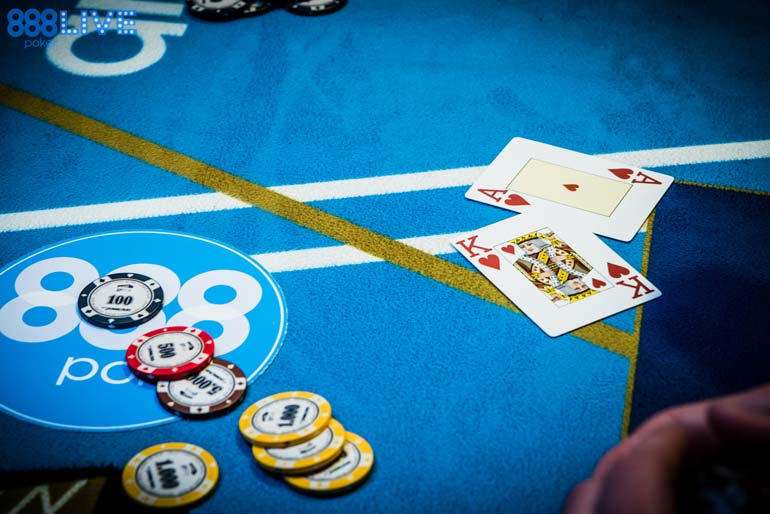
Optimal poker strategy has many variables –
- Who you’re playing
- How many chips you have
- How many chips your opponents have, and so on
But if you’re looking for where to begin, the easiest way to succeed in poker is by playing better cards than your opponents.
Ideally, you will want to study from a poker preflop chart (like the ones found here at 888; they are #7 and #8 on the list). When you’re starting to learn how to play, you can convert an 888 preflop chart into over 180 colour-coded flashcards!
That’s not realistic for everyone, however. And you probably are looking for an easier steppingstone.
Instead, start with these three essential criteria:
- Pairs. If you’re dealt two of the same card (ex., a pair of nines), it is generally a strong enough hand to play. Bigger pairs are better than smaller pairs – a pair of kings is better than a pair of threes. But to keep things simple, any pairs are fine and playable when starting out.
- Suited connectors. Aside from pairs, only play number cards if they are the same suit and consecutive. For example, an eight and a six of clubs is not good enough. The numbers are too far apart even though they are indeed the same suit. They need to be directly consecutive. So, an eight and a nine of clubs, or a seven and a six of clubs would pass. An eight and a seven of different suits? Trash! Be strict here – a hand like nine of hearts and ten of spades is a clear fold.
- BOTH face cards must be 10+! The most common beginner mistake is thinking that any ace is good. It’s not! Whenever you play face cards – an ace, king, queen, or jack – the second card must be ten or higher. Seriously!
- King and nine of clubs? Bad hand.
- Ace and eight? Bad hand.
- Queen and seven of diamonds? Throw it into the muck!
You will find that you end up folding way more than you expected. That’s OK! That’s normal!
Professional poker players fold around 80% of their starting hands.
So, if you’re mostly folding, you’re doing it right.
Levelling-Up
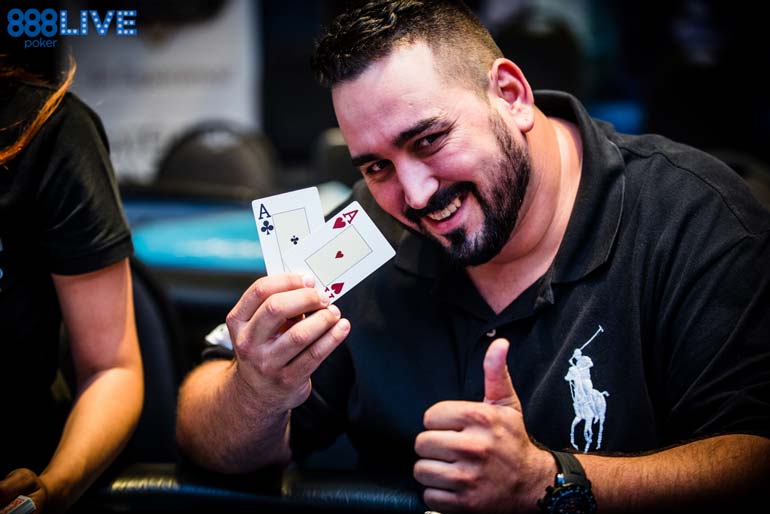
There are three primary levels in poker –
- Level One: What do I have?
- Level Two: What does my opponent have?
- Level Three: What does my opponent think that I have?
(And it just keeps going… what does my opponent think that I think that they think that I have?)
As you begin your poker journey, you will find yourself on Level One, trying to assess your hand’s strength. We’ve already learned that a hand like an ace and a seven is garbage.
How about a pair of aces? It depends on the board texture!
A pair of aces is terrific when the community cards are 2-2-3-K-J. But they’re not so great on a board like 6-7-8-J-Q. Your cards lose to many likely hands, such as two-pair or a straight. Deciphering the scenarios where your hand is strong vs weak is crucial.
(And hey, people struggle with poker hand rankings more than you think. Sometimes it’s hard to rate a flush or a straight!)
Say you have a fair grasp on whether your hand is worth betting (or calling someone else’s bets). The next level means thinking about what your opponent has.
For both levels, ask yourself these questions:
- Level One: What do I want to have happen? (If you have a good hand, you want to bet an amount you think will get paid. If you are bluffing, you want to bet an amount you feel will make your opponent fold.)
- Level Two: What does my opponent want to happen?
The jump up in levels may be challenging at first. But read between the lines. Say you realise your opponent is betting small because they are scared – you will have a considerable edge.
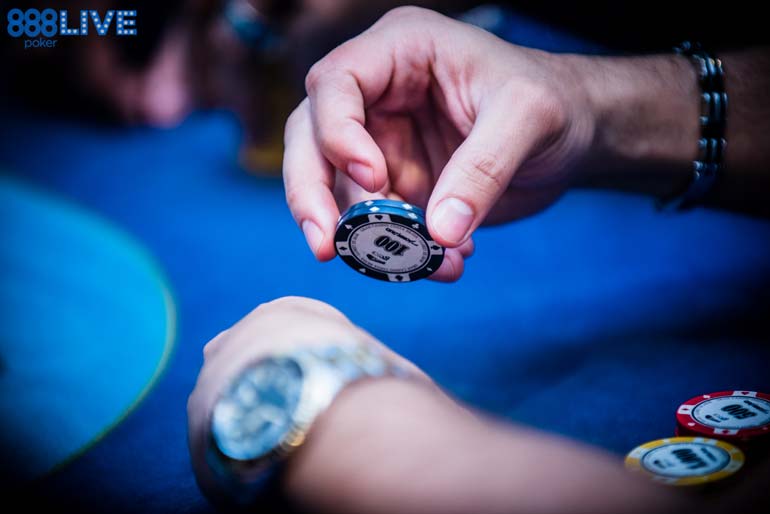
Here’s an example –
- Let’s say you bet with a pair of aces on this flop: K-10-9.
- Your opponent calls.
- The turn card is a Jack.
Is this card better for you or your opponent? Probably your opponent. Hands they likely called you on the flop with, such as KQ, JT, J9, and AQ, are all beating you now.
So, even though you have a pair of aces, you should not commit any more money to this pot. Your hand isn’t bad, but your opponent’s hand is likely better.
We have now reached the concept of relative hand strength!
This stage is the final level - plus bluffing.
Accelerate Your Growth
Finally, the best way to get better at poker is by playing online - the most effective and the quickest.
Allow for an explanation -.
- When you play live poker at a casino or home game, you will see an average of 30 hands per hour.
- When you play on your computer, that number triples – to an average of 90 hands per hour.
Warp speed! Most online players eventually graduate to playing multiple tables at once. So, that’s 90 hands per hour, per table.
You could be playing for five months, and an opponent who has been playing for five decades wouldn’t stand a chance!
Guys in their early thirties dominate the WSOP Main Event. Why is this? Wouldn’t you think they lacked decades of experience compared to more senior players? So, they’d be at a disadvantage?
Not so! The internet generation is the one who has the edge.
Let’s put it in numerical terms -
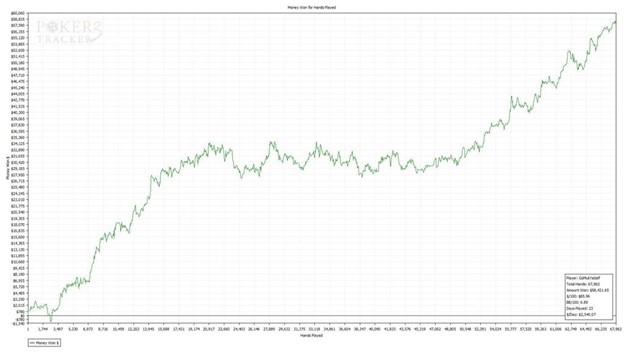
The above graph displays an online poker player’s results over 23 days (67,962 hands amounting to around $58K in winnings).
Again, this period is merely 23 days.
How long would it take you to see this many hands in a live environment?
Assuming you play poker as a full-time job – 40 hours per week – it would take you an entire year.
That’s right! You can accomplish in one month online what would take one year in the real world.
And the benefits are exponential -
- Online poker is more aggressive. People are prone to mess around, clicking buttons. It’s easier to bluff when shielded behind a screen rather than having to look someone straight in the eyes. So, the result is far more pressure plays. This situation is a good thing! If you can hold your own in the rough and tumble online streets, you will have a massive edge in live poker arenas, where the gameplay is much more passive.
- Did you know that computers can measure your aggression frequency? Playing more aggressively is a winning strategy – and necessary for success. Train yourself to battle online. So, live poker will be a walk in the park.
- Did you know that computers can measure your aggression frequency? Playing more aggressively is a winning strategy – and necessary for success. Train yourself to battle online. So, live poker will be a walk in the park.
- Online poker has more skilled players. Sure, there are fish online, like anywhere else. But you will also find the overall player pool has a better sense of what they are doing – particularly beyond microstakes. People aren't as focused, in your buddy's basement, as they're playing primarily for the social experience. Online there is more concentration. People play because they love cards and want to master the game.
Want to be the best? You’ve got to learn from the best.
All today’s most talented players are online crushers.
888poker is a great place to start.
